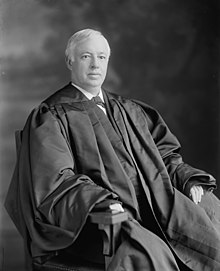Joseph Rucker Lamar
Joseph Rucker Lamar | |
|---|---|
 | |
| Associate Justice of the Supreme Court of the United States | |
| In office January 3, 1911 – January 2, 1916[1] | |
| Nominated by | William Howard Taft |
| Preceded by | William Moody |
| Succeeded by | Louis Brandeis |
| Justice of the Georgia Supreme Court | |
| In office 1901–1905 | |
| Member of the Georgia House of Representatives | |
| In office 1886–1889 | |
| Personal details | |
| Born | October 14, 1857 Ruckersville, Georgia, U.S. |
| Died | January 2, 1916 (aged 58) Washington, D.C., U.S. |
| Political party | Democratic |
| Spouse |
Clarinda Pendleton (m. 1879) |
| Children | 3 |
| Education | University of Georgia Bethany College, West Virginia (BA) Washington and Lee University School of Law (no degree) |
| Signature | |
Joseph Rucker Lamar (October 14, 1857 – January 2, 1916) was an
Biography
Born in
From 1886 to 1889, he served in the Georgia House of Representatives, and then was appointed by the Supreme Court of Georgia in 1893 as a member of the Commission to Recodify the Laws of Georgia, which prepared a code of laws for the state. Two years later, that code was adopted by the state General Assembly.
On January 1, 1901, Lamar was appointed to fill an unexpired term of Justice William A. Little in the Supreme Court of Georgia, then was re-elected in 1903. He wrote more than 200 opinions before resigning in 1905 to again practice law, defending railroads and many other large corporations.
On December 12, 1910, Lamar was
At a reception after Woodrow Wilson's inauguration in 1913, the two friends were able to meet again and swapped stories of their Georgia youth. They remained in contact while they were in Washington.
Lamar, together with
He died in Washington, D.C., on January 2, 1916.[7]
Legacy and honors
Lamar's professional papers, including correspondence concerning his years as a Justice, are archived at the University of Georgia in Athens, Georgia, and available for research. The Joseph Rucker Lamar Boyhood Home in Augusta, Georgia is listed on the National Register of Historic Places.
During World War II the Liberty ship SS Joseph R. Lamar was built in Brunswick, Georgia, and named in his honor.[8]
See also
References
- ^ a b "Justices 1789 to Present". Washington, D.C.: Supreme Court of the United States. Retrieved February 14, 2022.
- ^ ISBN 978-0-399-15921-3.
- ^ "Joseph Rucker Lamar (1857-1916)". August 5, 2013. Archived from the original on February 1, 2017. Retrieved February 2, 2017.
- ^ "Federal Judicial Center: Joseph Rucker Lamar". December 12, 2009. Archived from the original on May 13, 2009. Retrieved December 12, 2009.
- ^ McMillion, Barry J. (January 28, 2022). Supreme Court Nominations, 1789 to 2020: Actions by the Senate, the Judiciary Committee, and the President (PDF) (Report). Washington, D.C.: Congressional Research Service. Retrieved February 14, 2022.
- ISBN 0-7388-2410-0
- Lancaster New Era. January 3, 1916. p. 11. Archivedfrom the original on June 5, 2021. Retrieved December 26, 2020 – via Newspapers.com.
- ISBN 978-1476617541. Archivedfrom the original on October 14, 2021. Retrieved December 9, 2017.

